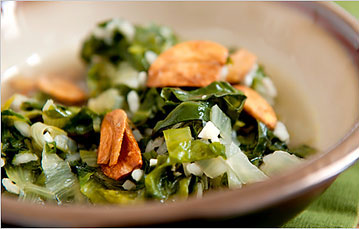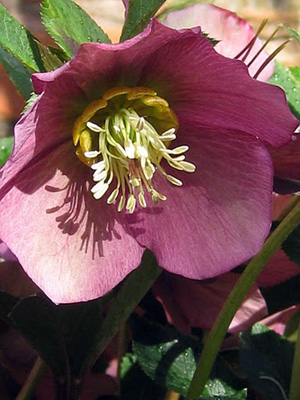 You probably know ricotta as the cheese that goes in lasagne or manicotti but ricotta is so much more. If you've ever had ricotta straight out of the container or tried freshly made ricotta, you know exactly what I mean. It's luscious, creamy and sweet all on its own. Ricotta is amazing simply spread on toast or served as a snack or appetizer. It can even be a dessert—I like it drizzled with honey.
You probably know ricotta as the cheese that goes in lasagne or manicotti but ricotta is so much more. If you've ever had ricotta straight out of the container or tried freshly made ricotta, you know exactly what I mean. It's luscious, creamy and sweet all on its own. Ricotta is amazing simply spread on toast or served as a snack or appetizer. It can even be a dessert—I like it drizzled with honey.
I had a dish of ricotta as a starter to a wonderful lunch at Il Buco Alimentari e Vineria. Even after platters of salumi, plates of pasta and panini, I was most enamored with a simple dish of ricotta with fava beans, so much so that I decided to recreate the dish at home. It's so easy to do that it's practically effortless and there's almost no cooking involved except for blanching the fresh favas.
Here it is much like the original. A drizzle of olive oil, salt, and pepper is the only flavoring the ricotta needs. Creamy spring fava beans add a nice textural contrast. And fresh herbs add bursts of flavor with every spoonful. Serve it over toasted bread, such as crostini, for the best pairing.
Spring
Spring
Ramp and Sorrel Soup
 I love unique spring vegetables—it's the reason why I write about such things like ramps and fiddleheads so much. For me there's nothing better than combining my favorites in one recipe to celebrate the spring season. Ramps on their own would make a particularly good soup. But looking for a contrasting flavor to pair it with, I thought of sorrel. With its tart and citrusy flavor, the leafy green is a perfect foil for pungent and oniony ramps.
I love unique spring vegetables—it's the reason why I write about such things like ramps and fiddleheads so much. For me there's nothing better than combining my favorites in one recipe to celebrate the spring season. Ramps on their own would make a particularly good soup. But looking for a contrasting flavor to pair it with, I thought of sorrel. With its tart and citrusy flavor, the leafy green is a perfect foil for pungent and oniony ramps.
This season the weather hasn't really brought us much of a warm spring just yet. Instead we've gotten endless chilly days, but luckily those days present us with the perfect opportunity to eat spring soups. Rich flavored, creamy soups are the best way to soothe and satisfy when you need uplift on a cold day. And say if suddenly the weather turns for the better, these types of soups are also great chilled on a warm day.
Roasted Asparagus and Grape Tomatoes with Crumbled Feta
For me nothing says "spring" more so than asparagus. As soon as the warm weather of early spring approaches, I start scouring the farmers' market for the first signs of asparagus. I'm always looking for the most slender green spears, ivory white ones, and even the dark purple-almost-black ones. I appreciate all types of asparagus.
I love asparagus cooked any which way except boiled—that's the reason I hated them so much as a kid because they I only ever had them boiled and overcooked. Even though they're not yet available at my most markets just yet, I've already begun cooking with asparagus. I'm just too eager to wait, so until they're available I won't mind the supermarket ones.
For this recipe I roast the asparagus to bring out their sweet taste. Alongside I also roast cherry tomatoes, which will become one of the many toppings for the dish. The dressing is a vinaigrette made from olives and lots of Dijon mustard. And finally the dish gets flourished with salty, tangy feta. This recipe is great as either an appetizer or a side dish.
A Reason to Be Bitter in Spring
From the New York Times
 Like radicchio and other bitter, tough greens, escarole can survive the winter in many places and appear early in spring. But unlike radicchio, escarole is inexpensive. And it’s more versatile: it tastes better cooked than does its round, red cousin.
Like radicchio and other bitter, tough greens, escarole can survive the winter in many places and appear early in spring. But unlike radicchio, escarole is inexpensive. And it’s more versatile: it tastes better cooked than does its round, red cousin.
In fact, escarole is at its most appealing when sautéed or braised, as the flavor becomes softer and even a bit buttery. It’s especially excellent with loads of garlic, and this traditional Italian soup — one of my go-to comfort recipes — is a prime example.
Though you might try other bitter vegetables here (watercress, curly endive, even celery come to mind), you definitely want short-grain rice, the kind used for risotto — arborio being the most familiar, though any short-grain rice, including those from Asia, will work well. All have a high starch content, so they turn creamy when they absorb liquid (which, by the way, should be homemade chicken stock, if at all possible). My second choice would be good vegetable or mushroom stock.
Lenten Roses
 During the season of Lent, an herbaceous perennial sends up its hearty bells of florets on sturdy stems – bridging the gap between winter and spring.
During the season of Lent, an herbaceous perennial sends up its hearty bells of florets on sturdy stems – bridging the gap between winter and spring.
As with the season of Lent itself – a wintry season of contemplation, spiritual focus, and petition - these symbols of new life out of the deathlike state of winter are emblems of the newness of spring, rebirth, and rejuvenation.
Helleborus is the genus name for Lenten Roses to which these perennials are often referred as Hellebores. Hellebores range from garnet to ruby, lilac to lavender, and to the purest white. Once the flowers begin to fade, the petals become chartreuse and lime green, lasting for months on their stems and for days in arrangements. Some of the flowers are the simplest, five petal blossoms you’ll ever see, while others are compound arrays of florets with freckles or dark nectaries complemented by bright sepals.
Leathery leaves, pretty and green, make for a delightful texture in the garden. The dark green of the Christmas Rose, Helleborus niger, is quite stunning around Christmas time and into January. The pure white flowers dangling above the glossy greenery are beautiful sentiments for the Christmas Holidays. From there, cultivars and cross species of Helleborus orientalis will begin to emerge and bloom through the winter and especially during Lent…quite an appropriate name, eh? From bloom time to color to texture, I’m sure you’ll be able to find a Hellebore to suit your garden’s fancy.
More Articles ...
Welcome to the new One for the Table ...
Our Home Page will be different each time you arrive.
We're sure you'll find something to pique your interest...


